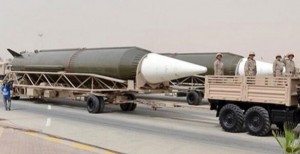Special to WorldTribune.com
WASHINGTON – Saudi Arabia’s display of its intermediate-range ballistic missile reflects the kingdom’s decision to operate independently of the United States, a report said.
The Washington Institute for Near East Policy asserted that the Saudi military parade on April 29 marked a message to both Iran and the United States.

Institute fellow Simon Henderson said this marked the first time Riyad displayed its Chinese-origin CSS-2 ballistic missile, designed to contain a nuclear warhead.
“The missile display signals Saudi Arabia’s determination to counter Teheran’s growing strength, as well as its readiness to act independently of the United States,” the report, titled “Saudi Arabia’s Missile Messaging,” said.
CSS-2, deemed inaccurate, was acquired by the Saudi military in 1987 and concealed in a mountain base south of Riyad. The liquid-fuel missile, with a range of 2,650 kilometers, was said to be operated and maintained by Pakistan and located within range of Iran.
The parade that contained CSS-2 was attended by Pakistan Chief of
Staff Gen. Raheel Sharif. Leaders of all six Gulf Cooperation Council states
also watched the missile in a ceremony at Hafer Batin that concluded
Abdullah Sword, deemed the largest ever exercise in Saudi Arabia.
“In particular, the presence of Pakistan’s top military commander will
reawaken speculation that Riyad may seek to acquire nuclear warheads from
Islamabad to match Iran’s potential,” the report, dated April 29, said.
Saudi Arabia was also said to have acquired the more advanced DF-21, a
solid-fuel IRBM, from Beijing. The report said the support vehicles at the
Saudi parade “may have been more suited to the newer missiles.”
“Both Saudi missile systems could probably be adapted relatively easily
to carry Pakistani nuclear warheads,” the report said.
The display of CSS-2 came a month after the visit by U.S. President
Barack Obama to Saudi Arabia. The report described Obama’s meeting with
Saudi King Abdullah as “difficult.”
“For Washington, the Saudi display is a reminder that Riyad remains
profoundly concerned about the course of events in the region,” the report
said. “As the dominance of U.S.-supplied equipment in the parade indicated,
Washington is still the kingdom’s preferred security partner, but the
relationship continues to show signs of being frayed.”

You must be logged in to post a comment Login